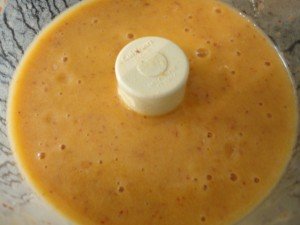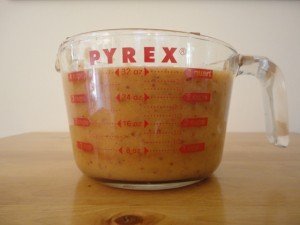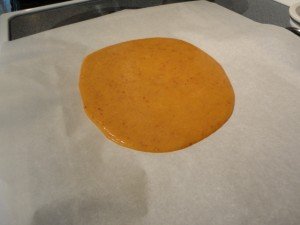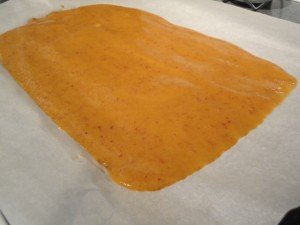Fruit Leather, Fruit Roll Ups, Fruit Rolls and Fruit Skin are just a few of the names used for fruit that has been pureed and then dried into a sheet. The difference between what is mass produced, commercially available and what can be made at home is literally the difference between night and day. This is not to say that I have not enjoyed both domestic and internationally produced fruit leather, but the process and result of what is made at home is much different than what is purchased in stores.
Recently I picked more fresh peaches then we could consume fresh. Aside from giving away some of the fruit, making homemade peach jam, peach liqueur, fresh peach sorbet and freezing peaches whole for future use, there still was fruit sitting in the refrigerator. I solicited the advice from my friend Karen who suggested that I experiment making fruit leather. She forwarded to me instructions from the book: Super Baby Food which I loosely followed. It appears that fruit leather has it’s origins in the Middle East, with the pronunciation in Arabic and Armenian respectively being amar addine and bastegh for dried sheets of Apricots.
There is relatively few ingredients and equipment needed to make homemade fruit leather in the kitchen; fresh fruit, food processor / blender measuring cup, spatula, large bowl (plastic or glass), parchment paper, oven, baking sheets and if desired, honey or a simple sugar syrup. Beyond these simple requirements, the most important thing that is required is time.
- To make one sheet of fruit leather, you will need approximately 6 Peaches (1.25 Pounds) to create 2 Cups of fruit puree. For my first attempt in making fruit leather, I doubled the recipe.
- Wash the peaches well, remove the pit and slice / dice in manageable pieces for the food processor or blender. No need to remove the skin for it provides texture, color and fiber to the fruit leather. Add one tablespoon of lemon juice for every 2 cups of puree to prevent discoloration.
- The puree should have the consistency of molasses or a thick applesauce. If not, then bring to a boil on medium high heat, turn off the heat and stir. I should have followed this step for the peach puree I created was too runny.
- Pour two cups of fruit puree onto the parchment paper, spreading the mixture evenly, keeping away from the edges of the baking pan to a thickness of 1/8-1/4 inch thick. Sounds easy? Not exactly, but trust your judgment.
- Place the baking sheet / sheets into the oven, middle racks and bake at the lowest possible temperature. My oven would go no lower than 175 degrees Fahrenheit. I kept the oven door cracked as instructed in order to lower the overall temperature in the oven. There are several techniques described on the internet for alternative ways to dry the fruit puree into fruit leather. One of these options may be more appropriate for your oven.
I allowed the peach puree to “dry” for about six hours, rotating the two trays every two hours. The time will depend on the temperature of the oven, the amount of liquid in the puree and the thickness of the puree on the parchment paper.
When the puree was no longer wet in the middle and appeared to have soft dried into a single sheet I removed the sheet of peach fruit leather from the oven. Once the fruit leather has cooled, the remove it from the parchment paper and cut it with scissors the desired length and width.
The net result of this experiment was that the first sheet was too brittle and instead of trying to salvage the center of the sheet into fruit leather strips, I ate the entire sheet. The peach flavor was pleasant; the texture despite being brittle was chewy and reminded me of the fruit roll ups I used to eat years ago. I felt no guilt for eating an entire sheet of fruit leather, for it was all natural with no additional additives. The second sheet separated from the parchment paper with no problem and I was able to cut the fruit leather into strips. The strips were then placed into an airtight container and store in the refrigerator.
In all it was a fun experiment to perform with the excess peaches. Peaches are not the only fruit that can be used to make fruit leather. With the exception of raspberries and blackberries (too many seeds), I cannot think of many other fruits that could not be made into this tasty and healthy treat. I am not sure if I would attempt this recipe again, but then I do not have children and can think of more adult themed uses for fresh picked peaches, i.e. Homemade Peach Liqueur or Peach & Mango Margaritas.






